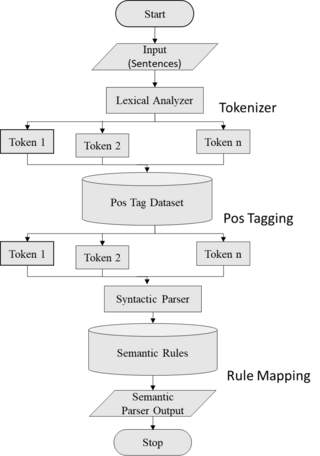Related Research Articles

In the industrial design field of human–computer interaction, a user interface (UI) is the space where interactions between humans and machines occur. The goal of this interaction is to allow effective operation and control of the machine from the human end, while the machine simultaneously feeds back information that aids the operators' decision-making process. Examples of this broad concept of user interfaces include the interactive aspects of computer operating systems, hand tools, heavy machinery operator controls and process controls. The design considerations applicable when creating user interfaces are related to, or involve such disciplines as, ergonomics and psychology.
Natural-language understanding (NLU) or natural-language interpretation (NLI) is a subset of natural-language processing in artificial intelligence that deals with machine reading comprehension. Natural-language understanding is considered an AI-hard problem.

A chatbot is a software application or web interface that is designed to mimic human conversation through text or voice interactions. Modern chatbots are typically online and use generative artificial intelligence systems that are capable of maintaining a conversation with a user in natural language and simulating the way a human would behave as a conversational partner. Such chatbots often use deep learning and natural language processing, but simpler chatbots have existed for decades.
Natural language generation (NLG) is a software process that produces natural language output. A widely-cited survey of NLG methods describes NLG as "the subfield of artificial intelligence and computational linguistics that is concerned with the construction of computer systems than can produce understandable texts in English or other human languages from some underlying non-linguistic representation of information".

Customer service is the assistance and advice provided by a company through phone, online chat, and e-mail to those who buy or use its products or services. Each industry requires different levels of customer service, but towards the end, the idea of a well-performed service is that of increasing revenues. The perception of success of the customer service interactions is dependent on employees "who can adjust themselves to the personality of the customer". Customer service is often practiced in a way that reflects the strategies and values of a firm. Good quality customer service is usually measured through customer retention.
A voice-user interface (VUI) enables spoken human interaction with computers, using speech recognition to understand spoken commands and answer questions, and typically text to speech to play a reply. A voice command device is a device controlled with a voice user interface.

A dialogue system, or conversational agent (CA), is a computer system intended to converse with a human. Dialogue systems employed one or more of text, speech, graphics, haptics, gestures, and other modes for communication on both the input and output channel.
A dialog manager (DM) is a component of a dialog system (DS), responsible for the state and flow of the conversation. Usually:
Artificial intelligence marketing (AIM) is a form of marketing that uses artificial intelligence concepts and models such as machine learning, Natural process Languages, and Bayesian Networks to achieve marketing goals. The main difference between AIM and traditional forms of marketing resides in the reasoning, which is performed by a computer algorithm rather than a human.
Natural-language programming (NLP) is an ontology-assisted way of programming in terms of natural-language sentences, e.g. English. A structured document with Content, sections and subsections for explanations of sentences forms a NLP document, which is actually a computer program. Natural language programming is not to be mixed up with natural language interfacing or voice control where a program is first written and then communicated with through natural language using an interface added on. In NLP the functionality of a program is organised only for the definition of the meaning of sentences. For instance, NLP can be used to represent all the knowledge of an autonomous robot. Having done so, its tasks can be scripted by its users so that the robot can execute them autonomously while keeping to prescribed rules of behaviour as determined by the robot's user. Such robots are called transparent robots as their reasoning is transparent to users and this develops trust in robots. Natural language use and natural-language user interfaces include Inform 7, a natural programming language for making interactive fiction, Shakespeare, an esoteric natural programming language in the style of the plays of William Shakespeare, and Wolfram Alpha, a computational knowledge engine, using natural-language input. Some methods for program synthesis are based on natural-language programming.
Natural-language user interface is a type of computer human interface where linguistic phenomena such as verbs, phrases and clauses act as UI controls for creating, selecting and modifying data in software applications.
A virtual assistant (VA) is a software agent that can perform a range of tasks or services for a user based on user input such as commands or questions, including verbal ones. Such technologies often incorporate chatbot capabilities to simulate human conversation, such as via online chat, to facilitate interaction with their users. The interaction may be via text, graphical interface, or voice - as some virtual assistants are able to interpret human speech and respond via synthesized voices.

Siri is the digital assistant that is part of Apple Inc.'s iOS, iPadOS, watchOS, macOS, tvOS, audioOS, and visionOS operating systems. It uses voice queries, gesture based control, focus-tracking and a natural-language user interface to answer questions, make recommendations, and perform actions by delegating requests to a set of Internet services. With continued use, it adapts to users' individual language usages, searches, and preferences, returning individualized results.
One Voice Technologies was an Artificial Intelligence (AI) based Natural Language Processing (NLP) company founded in 1998 and based in San Diego, CA. One Voice was the developer of IVAN, an intelligent personal assistant, which commercially launched in 1999. Some of the customers for One Voice Technologies are Telefonos de Mexico, S.A.B. de C.V. (TELMEX), Intel Corporation, the Government of India, Fry's Electronics, Inland Cellular, and Nex-Tec Wireless.
Amazon Lex is a service for building conversational interfaces into any application using voice and text. It powers the Amazon Alexa virtual assistant. In April 2017, the platform was released to the developer community, and suggested that it could be used for conversational interfaces including Web, mobile apps, robots, toys, drones, and more. Amazon already had launched Alexa Voice Services, which developers can use to integrate Alexa into their own devices, like smart speakers, alarm clocks, etc.; however, Lex will not require that end users interact with the Alexa assistant per se, but rather any type of assistant or interface. As of February 2018, users can now define a response for Amazon Lex chatbots directly from the AWS management console.

Haptik is an Indian enterprise conversational AI platform founded in August 2013, and acquired by Reliance Industries Limited in 2019. The company develops technology to enable enterprises to build conversational AI systems that allow users to converse with applications and electronic devices in free-format, natural language, using speech or text. The company has been accorded numerous accolades including the Frost & Sullivan Award, NASSCOM's Al Game Changer Award, and serves Fortune 500 brands globally in industries such as financial, insurance, healthcare, technology and communications.

Semantic parsing is the task of converting a natural language utterance to a logical form: a machine-understandable representation of its meaning. Semantic parsing can thus be understood as extracting the precise meaning of an utterance. Applications of semantic parsing include machine translation, question answering, ontology induction, automated reasoning, and code generation. The phrase was first used in the 1970s by Yorick Wilks as the basis for machine translation programs working with only semantic representations. Semantic parsing is one of the important tasks in computational linguistics and natural language processing.
Virtual assistants are software technology that assist users complete various tasks. Well known virtual assistants include Amazon Alexa, and Siri, produced by Apple. Other companies, such as Google and Microsoft, also have virtual assistants. There are privacy issues concerning what information can go to the third party corporations that operate virtual assistants and how this data can potentially be used.
References
- ↑ "What Are Conversational Interfaces? The Basics". CX Today. 2020-12-11. Retrieved 2021-07-22.
- ↑ "Conversational Interfaces: Where Are We Today? Where Are We Heading?". Smashing Magazine. 18 July 2016. Retrieved 2018-05-23.
- ↑ Brownlee, John (2016-04-04). "Conversational Interfaces, Explained". Co.Design. Retrieved 2018-05-23.
- ↑ Brownlee, Jason (2017-09-21). "What Is Natural Language Processing?". Machine Learning Mastery. Retrieved 2021-07-22.
- ↑ Pan, Jiaqi (2017-08-25). "Conversational Interfaces: The Future of Chatbots – Chatbots Magazine". Chatbots Magazine. Retrieved 2018-05-23.
- ↑ Lola (2016-10-05). "NLP vs. NLU: What's the Difference? – Lola – Medium". Medium. Retrieved 2018-05-23.
- ↑ "Integrating The Best Chatbots With Apps & Assistants". Voicify. Retrieved 2021-07-22.
- ↑ "Conversational User Interfaces: In-depth Guide [2021 update]". research.aimultiple.com. 2018-03-01. Retrieved 2021-07-22.
- ↑ "The History of Chatbots - from ELIZA to Alexa". 12 October 2017.
- ↑ "What is a Chatbot and How Does it Work?". SearchCustomerExperience. Retrieved 2021-07-22.
- ↑ "BotPenguin".